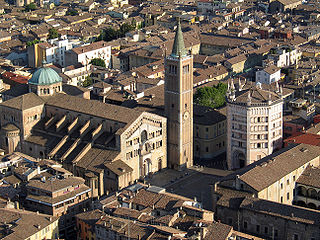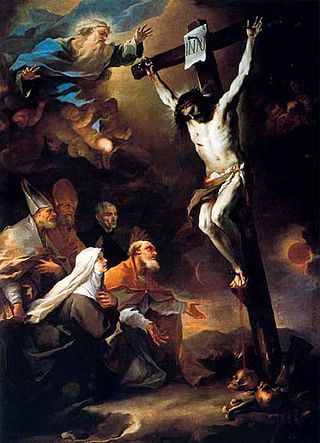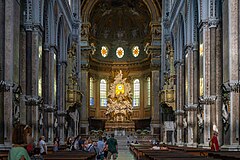
Januarius, also known as Januarius I of Benevento, was Bishop of Benevento and is a martyr and saint of the Catholic Church and the Eastern Orthodox Church. While no contemporary sources on his life are preserved, later sources and legends claim that he died during the Great Persecution, which ended with Diocletian's retirement in 305.

Domenico Zampieri, known by the diminutive Domenichino after his shortness, was an Italian Baroque painter of the Bolognese School of painters.

The Feast of San Gennaro, also known as San Gennaro Festival, is a Neapolitan and Italian-American patronal festival dedicated to Saint Januarius, patron saint of Naples and Little Italy, New York.

Giovanni Lanfranco was an Italian painter of the Baroque period.

Bologna Cathedral, dedicated to Saint Peter, is the cathedral of Bologna in Italy, and the seat and the metropolitan cathedral of the Archbishop of Bologna. Most of the present building dates from the 17th century, with a few parts from the late 16th century.

Parma Cathedral is a Roman Catholic cathedral in Parma, Emilia-Romagna (Italy), dedicated to the Assumption of the Blessed Virgin Mary. It is the episcopal seat of the Diocese of Parma. It is an important Italian Romanesque cathedral: the dome, in particular, is decorated by a highly influential illusionistic fresco by Renaissance painter Antonio da Correggio.

Santa Restituta is a church in Naples, southern Italy, dedicated to Saint Restituta. The foundation of the basilica is attributed to the Emperor Constantine the Great in the 4th century and is mentioned in a passage from the life of Pope Sylvester I in the Liber pontificalis:
Patricia of Naples is an Italian virgin and saint. Tradition states that she was noble; she may have been related to the Roman Emperor. Some sources say that she was a descendant of Constantine the Great. The particulars traditional about her are unreliable and in some instances contradictory.
Bernardino Realino was an Italian Roman Catholic priest and a professed member of the Jesuits. His entire career was devoted to the areas of Naples and Lecce. Realino pursued a career in law and served in several municipal capacities before feeling called to the Jesuit life and being ordained to the priesthood in Naples. He is often dubbed as the "Apostle of Lecce" for his commitment to the poor and for his preaching abilities.

Aspren or Asprenas was a 1st-century Christian saint and venerated as the first Bishop of Naples.

Pistoia Cathedral, or Cathedral of Saint Zeno is the main religious building of Pistoia, Tuscany, central Italy, located in the Piazza del Duomo in the centre of the city. It is the seat of the Bishop of Pistoia and is dedicated to Saint Zeno of Verona.

Arezzo Cathedral is a Roman Catholic cathedral in the city of Arezzo in Tuscany, Italy. It is located on the site of a pre-existing Palaeo-Christian church and, perhaps, of the ancient city's acropolis.

Amalfi Cathedral is a medieval Roman Catholic cathedral in the Piazza del Duomo, Amalfi, Italy. It is dedicated to the Apostle Saint Andrew whose relics are kept here. Formerly the archiepiscopal seat of the Diocese of Amalfi, it has been since 1986 that of the Diocese of Amalfi-Cava de' Tirreni.

Matera Cathedral is a Roman Catholic cathedral in Matera, Basilicata, Italy. It is dedicated to the Virgin Mary under the designation of the Madonna della Bruna and to Saint Eustace. Formerly the seat of the Bishops, later Archbishops, of Matera, it is now the cathedral of the Archdiocese of Matera-Irsina.

Christianity and religion in general has always been an important part of the social and cultural life of Naples. It is the seat of the Archdiocese of Naples, and the Catholic faith is highly important to the people of Naples and there are hundreds of historic churches in the city. The Cathedral of Naples is the most important place of worship in the city, each year on September 19 it hosts the Miracle of Saint Januarius, the city's patron saint. In the miracle which thousands of Neapolitans flock to witness, the dried blood of Januarius is said to turn to liquid when brought close to relics said to be of his body: this is one of the most important traditions for Neapolitans.

The Royal Chapel of the Treasure of St. Januarius, or the Reale cappella del Tesoro di San Gennaro, is a chapel located in the Cathedral of Naples, Italy, and dedicated to St. Januarius, patron saint of the city. This is the most lavishly decorated chapel in the cathedral, and contains contributions by the premier Baroque artists in Naples.

The Cabal of Naples was a notorious triumvirate of painters in the city of Naples that operated during the early Baroque period from the late 1610s to the early 1640s. It was led by the Spaniard Jusepe de Ribera, who had established himself in Naples after fleeing creditors in Rome in 1616, and also consisted of the Neapolitan Battistello Caracciolo and Greek Belisario Corenzio. Its primary goal was to prevent competition from artists from other parts of Italy, particularly the masters. Its activities often targeted the followers of Annibale Carracci, but also any artist not native to Naples. It involved the triumvirate in leading the painters of the city to harass, expel, or poison any non-native painter, and only ended with the death of Caracciolo in 1641.

Nola Cathedral is a Roman Catholic cathedral in Nola, a municipality within Naples in Campania, Italy, dedicated to the Assumption of the Virgin Mary. It is the episcopal seat of the Diocese of Nola. It was granted the status of a minor basilica in March 1954.

Saint Januarius Emerges Unscathed from the Furnace is an oil on copper painting by Jusepe de Ribera, commissioned in 1643 and completed three years later, in 1646. It is now in the Royal Chapel of the Treasure of St. Januarius in Naples Cathedral. It shows a legend relating to Naples' patron saint Januarius, shown as a bishop.

Fano Cathedral is the principal church of Fano, Marche, Italy. Originally the seat of the bishop of Fano, since 1986 it has been the episcopal seat of the Diocese of Fano-Fossombrone-Cagli-Pergola. In January 1953 Pope Pius XII elevated it to the rank of a basilica minor.




















